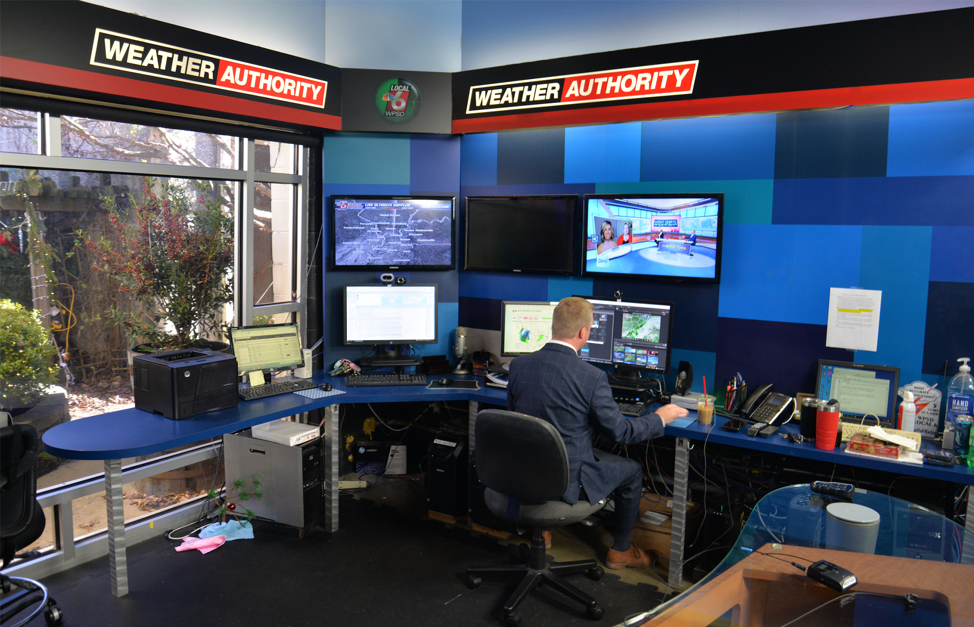When WPSD meteorologist Trent Okerson met his new boss, news director Perry Boxx, for the first time in March 2018, Boxx asked him, “What is your job?”
“I forecast the weather,” Okerson remembers saying.
“No,” Boxx said. “We save lives. We track storms.”
On the night of Dec. 10, Okerson came to understand exactly what his boss meant.
For more than three days, he had been telling the people of Mayfield, Princeton and Dawson Springs, Kentucky, that something was coming as a storm system developed in Arkansas and Missouri and boiled toward Kentucky.
Hours before the storms made their deadly landing, Okerson, who is based in Paducah, calmly told viewers the exact path the storm would take. He told them the minute it would arrive. He said it would be a violent night.
Sadly, his forecast was precisely right.
What follows is a day-by-day and minute-by-minute breakdown of Okerson’s coverage of a swarm of tornadoes that killed at least 88 people and leveled homes and businesses in the midst of the holiday season.
Tuesday, Dec. 7: “We started noticing what looked to be the signature of a severe weather threat forming out west,” Okerson told me in a raspy, overworked voice. “We drew our outlook map and we started telling our viewers to stay in touch. I was concerned.”
Okerson grew up just across the Ohio River from Paducah in Metropolis, Illinois. He joked that while children would go home after school and watch cartoons, he went home and watched The Weather Channel. WPSD was his favorite local TV station.
“I talked about weather all the time,” Okerson said. “For my sixth birthday, I got to come to the TV station to meet Cal Sisto, Channel 6’s meteorologist. He gave me a thermal image map.”
Thursday, Dec. 9: “I told the viewers that we were seeing severe weather parameters we have never seen before around here,” Okerson said.
He said his weather computers were showing what meteorologists call “significant tornado parameters,” which include wind shear. “On a one to 10 scale,” he said, “a one would be significant enough to touch off a tornado. A two would be a high potential for a storm. We were at a five or six already with the storm several states to the west still.”
That morning, Okerson taught sixth-graders at a Mayfield school. “We talked about tornado safety. I was thinking about those kids Friday night. I almost lost it thinking about them.”
Friday, Dec. 10: “The significant tornado parameters now pegged at an eight or nine,” Okerson said. “We were going to have a disaster and the track was becoming clearer. We escalated to what we call ‘weather authority’ coverage, which means constant live updates through the day, every newscast leads with weather and weather gets as much time on the air as the meteorologist wants.”
You would expect as much from a newsroom that is decorated with posters of the U.S. Constitution, the Bill of Rights and the First Amendment.
6:31 p.m.: Just as Lester Holt was opening the “NBC Nightly News,” Okerson broke into programming with an ominous new warning for the Bootheel area of Missouri, right on WPSD’s western edge of coverage.
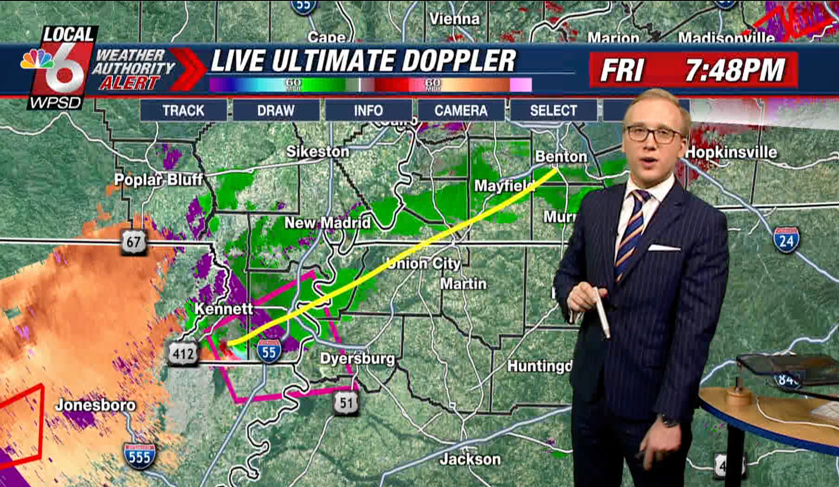
Meteorologists Noah Bergren and Kaylee Bowers stayed on the air with Noah Okerson throughout the night tracking the storm. . (Courtesy: WPSD)
7:48 p.m.: “This thing looks really really nasty,” Okerson told viewers. “I try not to use hyperbole or scare people so when I need for them to pay attention, they know I mean it.”
As the first images of a growing supercell of storms on the edge of WPSD’s coverage area grew closer, another WPSD meteorologist, Noah Bergren, drew a yellow line on the map stretching from Kennett, Missouri, toward Mayfield, Kentucky. “This is kind of the long-range path,” Bergren said. “If this thing stays on the trajectory, it will be something like this.”
WPSD’s forecast would prove to be chillingly accurate. It was two hours before the storm’s deadly touchdown.
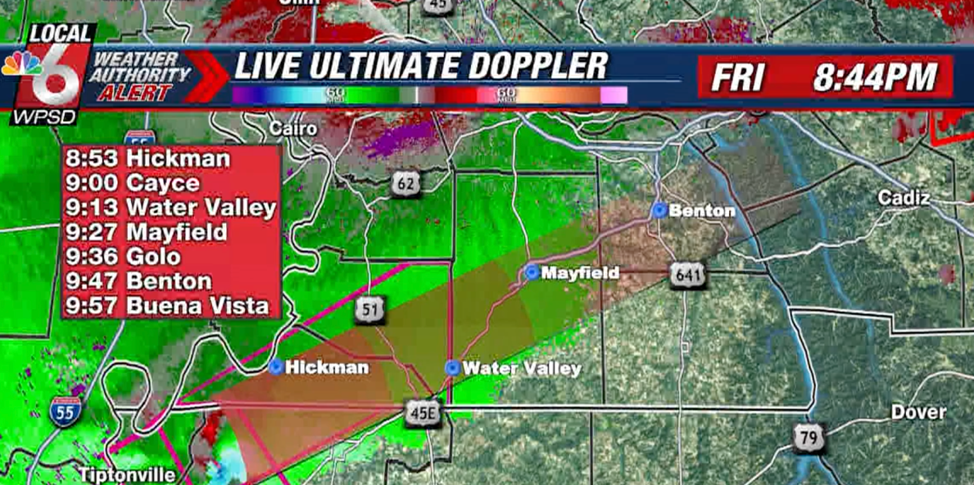
WPSD aired times when viewers could expect the storm to reach their area. (Courtesy: WPSD)
8:44 p.m.: The station had been on constant coverage and the storm moved closer and gathered strength.
Okerson popped the newest storm track on the air. Mayfield, he said, could expect a direct hit at 9:27 p.m.
“There is no reason to think this is not going to go on,” he warned. “This is an extremely rare, incredibly dangerous, long track trail tornado.”
The threat turned into a promise. Workers at one local factory had time to get to safety, but many others didn’t. Families huddled in bathrooms, people living in mobile homes left. One man sat in his bathroom tub and prayed.
8:54 p.m.: “If you have a bike helmet, if you have a baseball helmet, put it on,” Okerson told viewers in the path of the storm.
8:56 p.m.: “Mayfield, it is coming for you. There is no reason to believe it won’t.”
9:04 p.m.: Okerson said something he has never said on TV.
“Guys, this is a life-threatening tornado,” he said. “It is here, it is on top of you right now. You have to be in your place of shelter.”
He mentioned the country roads it would cross.
“This is an extremely dangerous, catastrophic tornado that we are dealing with.”
He pointed to the debris signature, which indicated the storm was already inhaling trees.
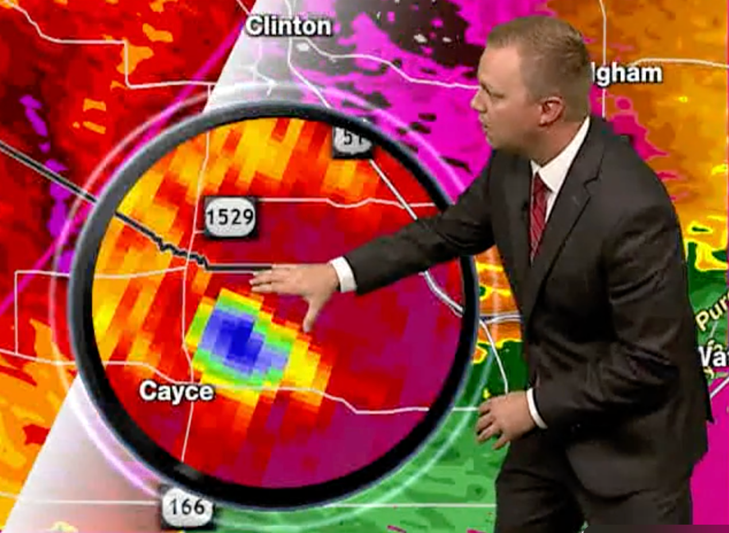
WPSD meteorologist Trent Okerson points out a debris signature, which indicated the storm was strong. (Courtesy: WPSD)
“You see this ball right here?” he said. “There is zero doubt that we have incredible damage being done right now with this storm.”
It was still moving through what was mostly sparsely populated rural countryside, but it was heading for bigger towns.
Over and over, he implored people to get to a safe place, take cover, evacuate mobile homes.
“I told people in my 14 years on the air, I have never seen anything like this on radar.”
9:08 p.m.: “Mayfield, there is no doubt this storm is headed in our direction. It is producing a life-threatening, very destructive tornado.”
“If you live in a mobile home in Mayfield, you have to get out of it. Get to a neighbor’s house, a friend, a family, and get to a home and put as many walls between you and the outside as you can.”
Robert Lowery lived in a mobile home outside of Mayfield.
“When they told me (on TV) exactly where it was coming, I was leaving,” he said. “‘You need to leave and find somewhere to go,’ and that is exactly what we did. Less than 20 minutes after we left, this house was gone.”
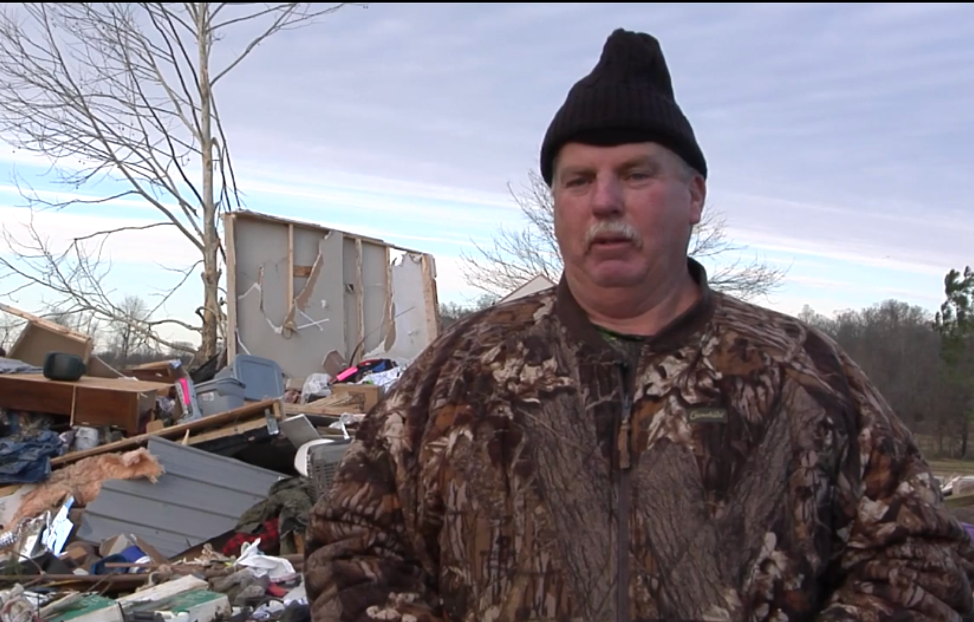
Robert Lowery watched Okerson track the storm for three days. He left his mobile home with his wife, children and dog minutes before the tornado destroyed his home. (Courtesy: WPSD)
9:27 p.m.: The storm that had announced its intentions as early as Tuesday delivered on the threat.
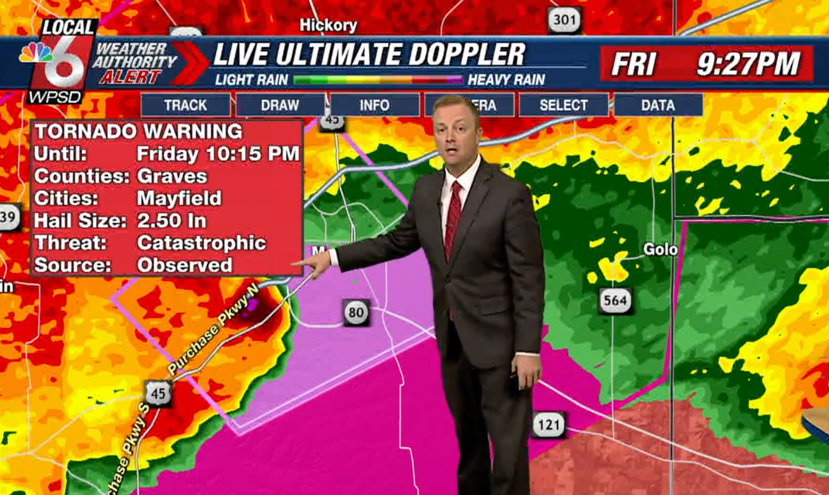
This is the moment that the tornado devastated Mayfield, Kentucky. The time was 9:27 p.m., exactly the time Okerson predicted it would arrive. “There is no lead time that is enough,” he said. (Courtesy: WPSD)
For the first time in hours, Okerson looked at the screen silently for a second then said, “Send some prayers to Mayfield right now.”
But there was no time to grieve, or stay silent. He zoomed in to show street by street where it would hit. “Guys, this is it,” he said calmly into the camera.
“It was surreal. I had to stop a couple of times,” he told me. “There were a couple of times I almost cracked. I thought of those sixth graders I was with the day before. When you see that on the radar, it was a mile-wide storm. For sure people were going to die in two minutes and there is not one thing I can do about that.”
He stopped talking for a moment. Then he said, “At a time like that, you have to compartmentalize and say ‘I will deal with my emotions later.’ As bad as it was, as bad as it was going to be, my job at that moment is to track the storm. The storm is not over.”
For another hour, WPSD tracked the unfolding horror while crews fanned out to begin documenting the death and damage.
10:21 p.m.: Just as he had predicted hours earlier, a tornado hit Princeton, Kentucky, and flattened a subdivision.
10:33 p.m.: A tornado pulled a 2-month-old baby and her parents out of their Dawson Springs home’s bathroom and blew them across the street. The baby was one of 13 people who died in the town with a population of 2,000.
“Thousands of people’s lives changed that night,” Okerson said, looking at the floor.
Nobody watching him Friday night knew that he was running a fever during the marathon coverage that he was on the air. Around 3:15 a.m., he collapsed into bed. He got back up a few hours later and sent his boss, Boxx, a message which Okerson allowed me to share.
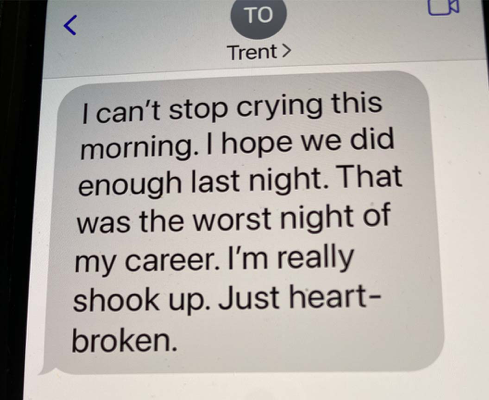
(Courtesy: Trent Okerson)
“I am so proud of him,” Boxx said. “This is his town, his people. I wish people knew what our people are going through when they cover this stuff. If you want to be a journalist, you do not get callous and you do not stop caring.”
Lowery sent a video message to Okerson.
“They (WPSD) saved my life, my brother’s life, his wife, my mother, every one of them,” he said. “We got every vehicle we had and drove them out of here. If we hadn’t, we wouldn’t have had no cars, we would not have had no life, we wouldn’t be here.”
He added, “It if hadn’t been for them, I would be laying there dead.”
As we walked down the hallway at WPSD, Boxx looked over his shoulder.
“Hey Trent, what do we do here?”
The response was quiet and quick. “We save lives and track storms.”
“That’s right, that’s right,” Boxx said.
More from Poynter:
- How a local radio station is helping a tornado-battered Kentucky community put itself back together
- CNN anchor Pamela Brown isn’t just covering the tornado damage in Kentucky. She’s reporting on her home.
- Reporters and photojournalists share stories from the 60-mile path of tornado destruction in Kentucky
- Exhausted journalists are rising to the Kentucky tornado disaster
- How the media is covering the horrific scene in Kentucky
This story was updated to include reference to two more WPSD meteorologists.

